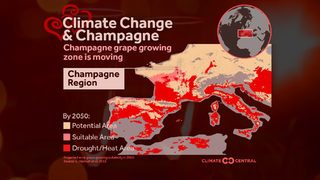Recently, our team of meteorologists noticed that during the last three years, Central Florida has had temperatures in the 80s during a stretch of a week (or two) in the month of February. The warming is clearly noticeable, not just in Central Florida but across the entire state.
Watch: Coincidence? Stretch of 80s in February in the last 3 years.
Florida has warmed about 2 degrees Fahrenheit since 1970. It's not just about the warming itself, though -- we must also notice the rate at which we are warming, which is critical for the ecosystem and our own health.
Beyond Florida, states across the Northeast have the fastest warming rates, with February temperatures rising about 4 degrees Fahrenheit since 1970. Climate Central, an independent organization surveying and conducting scientific research on climate change, notes that seven of the 10 fastest-warming states are in the Northeast and they also have the fastest-warming winters in the country.
There are some states that show a slight downward trend of average temperatures for the month of February since 1970. The greatest decrease is in Wyoming, but it was a decrease of 0.8 degrees Fahrenheit, a much smaller decline than the faster-warming Northeast states.
The rate of change is key in these findings, especially as the release of greenhouse gases into the atmosphere continues increasing in the U.S and across the globe.
%
%
Valentine's Day favorites and Climate
You've probably seen them in stores shortly after Christmas ended --
lots of Valentine's Day chocolates and roses ready and stocked.
lots of Valentine's Day chocolates and roses ready and stocked.
But where do these millions of flowers come from? Where do they grow?
Roses are a $20 billion business. Sixty percent of the flowers sold in the U.S. comes from Colombia or Ecuador. To meet the high demand for the date, these flowers are grown in greenhouses and flown right to Miami International Airport. Each plane brings $1 million worth of roses, or about 300,000 roses. Soon after their arrival, they are placed in a 40 degree warehouse (those rising Florida temperatures come back into play, here) so they can be inspected by federal agents before heading to stores.
Just to meet the demand in the U.S., 100 million roses are grown for Valentine’s Day, and that produces about 9,000 metric tons of CO2.
WATCH: CLIMATE AND ALLERGENS
How about the another favorite, chocolate?
Chocolate factories reach all-time-high sales (and production) in February, but it starts well before the factories are put to work, in the cocoa trees growing in regions where chocolate would melt in your hands.
Cocoa has very unique and specific growing conditions. Temperatures have to be uniform, there must be high humidity and abundant rain, soil has to be rich in nitrogen and there mustn't be too much wind. Rain forests are a prime environment for cocoa growth.

Côte d’Ivoire, Ghana and Indonesia are the leading producers of chocolate. Research by the Intergovernmental Panel on Climate Change (IPCC) shows that if the climate scenario doesn’t change by 2050, there will be a marked reduction in suitable cultivation areas for cocoa.
WATCH MORE WEATHER FACTS AND HACKS
Ironically, the danger doesn't come directly from warming temperatures, but from increasing evapotransportation. Evapotransportation is the process by which water is transferred from the land to the atmosphere by evaporation from the soil and other surfaces and transpiration from plants. More specifically, as the plants in the rain forests release more water due to higher temperatures, the moisture lost will not be replenished at the same rate by rainfall.
Adaptation is the key. Since we are looking at a deadline of 2050, there is still a bit of time to adapt and change so that we and future generations can continue enjoying chocolate treats. There remains time for cocoa farmers to continue making a living by meeting global demand and maintaining the habitats in which they farm.
If you are not into the chocolate or roses and just want to celebrate with a glass of bubbly, here are some Champagne facts:
- Champagne sold in the U.S. cannot be called Champagne unless it is made from the actual grapes grown in the Champagne region of France (not Illinois).
- Although the warming temperatures have increased the quality in wine production, the rate of warming continues to accelerate at a very fast pace. This means that the projected 2°C/3.6°F rise in temperatures by mid-century would push the Champagne region out of its peak production climate.
- Wine and champagne production will have to continue moving northward in order to continue growth and keep the quality of the products. But, many industries and cities such as Champagne in France and even national wineries will have to adapt to the changes, potentially losing millions and directly affecting their workers. Even you, the celebrant, will be affected.

Cox Media Group




